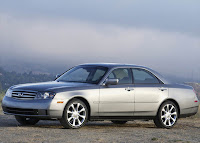Jaguar XJ13, 1966
The Jaguar XJ13 was a prototype racing car developed by Jaguar to challenge at Le Mans in the mid-1960s. It never raced, and only one was ever produced.
Jaguar had considered the manufacture of a V12 engine as far back as 1955, initially for racing purposes, and then developing a road going version, unlike the XK which was designed as a production engine and later pressed into service for racing. The engine design was essentially two XK 6-cylinder engines on a common crankshaft with an aluminium cylinder block, although there were differences in the inlet porting, valve angles and combustion chamber shape. The first engine ran in July of 1964.
The idea of a mid-engined prototype was first mooted in 1960, but it was not until 1965 that construction began, with the first car running by March 1966. The aluminium body was designed by Malcolm Sayer, the aerodynamicist responsible for the Jaguar C-Type, D-Type, E-Type and XJ-S, who used his Bristol Aeroplane Company background to build it using techniques borrowed from the aircraft industry.
The Jaguar XJ13 had mid-engine format with the 5.0 litre V12 engine mounted behind the driver, used as a stressed chassis member together with the five-speed manual ZF Transaxle driving the rear wheels.
The front suspension wishbones were similar to that of the E-Type, however where the E-Type used longitudinal torsion bars, the Jaguar XJ13 had more conventional coil spring/damper units. At the rear there again remained similarities with the E-Type - the use of driveshafts as upper transverse links - however the rest was quite different, with two long radius arms per side angling back from the central body tub together with lower links.
The development of the Jaguar XJ13, although treated seriously by the designers, was never a priority for company management (despite assistant MD Lofty England's Le Mans success in the 1950s), and became less so following the 1966 merger with BMC. By that time Ford had developed the 7.0 litre GT40, and so the Jaguar XJ13 was considered obsolete by the time the prototype was complete. The prototype was tested at MIRA and at Silverstone, which confirmed that it would have required considerable development to make it competitive. The prototype was put into storage and no further examples were made.
The Jaguar XJ13 was a prototype racing car developed by Jaguar to challenge at Le Mans in the mid-1960s. It never raced, and only one was ever produced.
aguar had considered the manufacture of a V12 engine as far back as 1955, initially for racing purposes, and then developing a road going version, unlike the XK which was designed as a production engine and later pressed into service for racing. The engine design was essentially two XK 6-cylinder engines on a common crankshaft with an aluminium cylinder block, although there were differences in the inlet porting, valve angles and combustion chamber shape. The first engine ran in July of 1964.
The idea of a mid-engined prototype was first mooted in 1960, but it was not until 1965 that construction began, with the first car running by March 1966. The aluminium body was designed by Malcolm Sayer, the aerodynamicist responsible for the Jaguar C-Type, D-Type, E-Type and XJ-S, who used his Bristol Aeroplane Company background to build it using techniques borrowed from the aircraft industry.
The Jaguar XJ13 had mid-engine format with the 5.0 litre V12 engine mounted behind the driver, used as a stressed chassis member together with the five-speed manual ZF Transaxle driving the rear wheels.
The front suspension wishbones were similar to that of the E-Type, however where the E-Type used longitudinal torsion bars, the Jaguar XJ13 had more conventional coil spring/damper units. At the rear there again remained similarities with the E-Type - the use of driveshafts as upper transverse links - however the rest was quite different, with two long radius arms per side angling back from the central body tub together with lower links.
The development of the Jaguar XJ13, although treated seriously by the designers, was never a priority for company management (despite assistant MD Lofty England's Le Mans success in the 1950s), and became less so following the 1966 merger with BMC. By that time Ford had developed the 7.0 litre GT40, and so the Jaguar XJ13 was considered obsolete by the time the prototype was complete. The prototype was tested at MIRA and at Silverstone, which confirmed that it would have required considerable development to make it competitive. The prototype was put into storage and no further examples were made.














